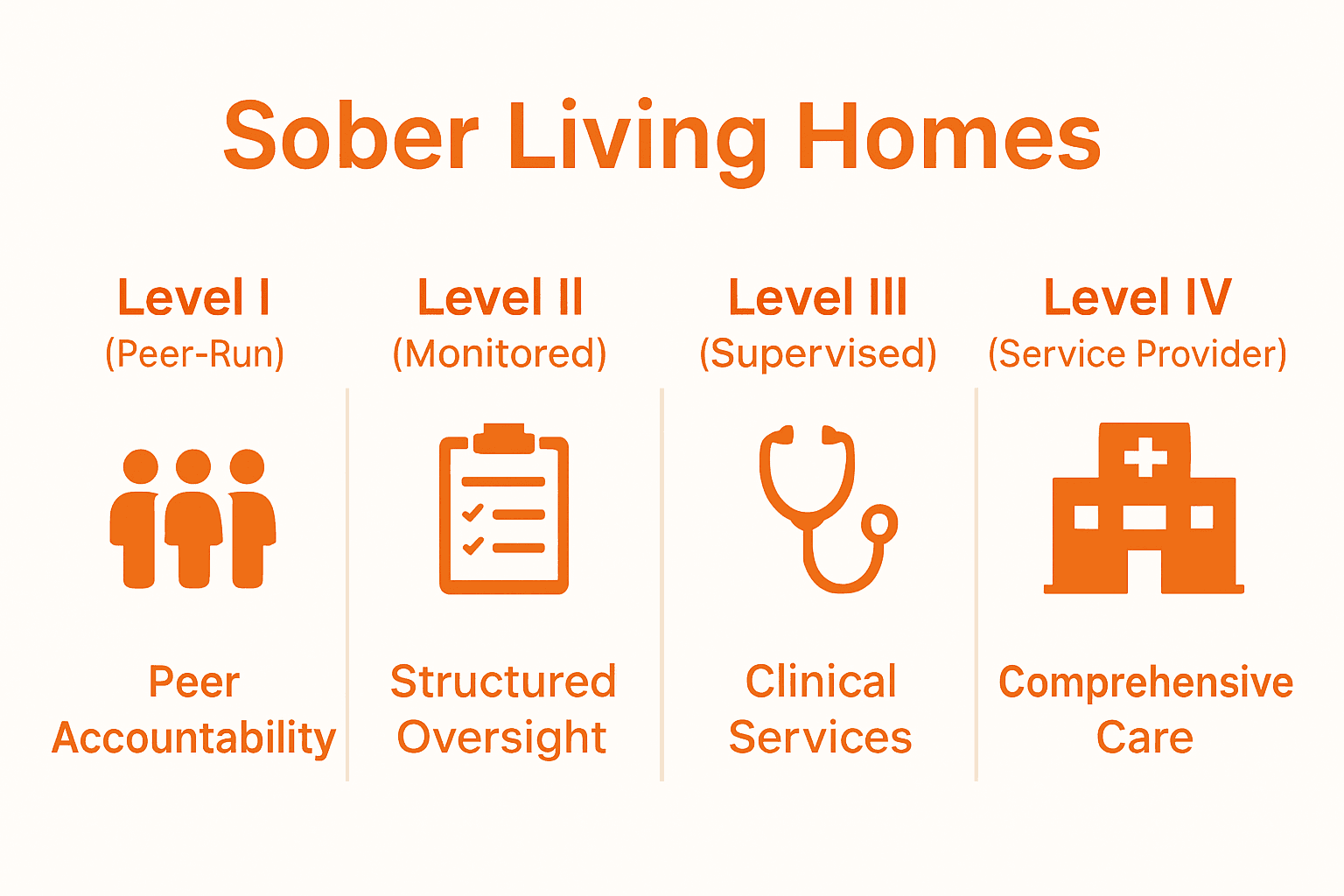More than 40 percent of people relapse within a year after leaving addiction treatment, showing just how tough the road to recovery can be. The gap between rehab and independent living often feels overwhelming for those seeking long-term change. Sober living homes fill this gap by offering safe, substance-free environments where residents build routines, develop life skills, and find the stability needed for lasting recovery.
Table of Contents
- Defining Sober Living And Its Purpose
- Different Types Of Sober Living Homes
- Core Benefits For Individuals In Recovery
- Role Of Support Systems And Community
- Challenges And Barriers To Sober Living
- Accessing Sober Living In San Diego
Key Takeaways
| Point | Details |
|---|---|
| Purpose of Sober Living | Sober living environments serve as a structured transitional space for individuals recovering from addiction, promoting accountability, abstinence, and stability. |
| Types of Sober Living Homes | There are four levels of sober living homes, each offering varying degrees of support and structure to cater to individual recovery needs. |
| Core Benefits | Sober living homes provide essential support, including structured routines, peer networks, and skill development opportunities, fostering a pathway to long-term recovery. |
| Challenges | While beneficial, sober living environments face challenges like interpersonal conflicts and psychological barriers that may impede recovery and require careful management. |
Defining Sober Living and Its Purpose
Sober living environments represent a critical bridge in the addiction recovery journey, offering individuals a structured and supportive transition from intensive rehabilitation to independent living. According to en.wikipedia.org, these are alcohol and drug-free living spaces designed to help individuals maintain abstinence while rebuilding their lives after treatment.
The primary purpose of sober living houses goes beyond mere housing. They create a safe, controlled environment that supports residents in their ongoing recovery process. As outlined by sbprobation.org, these environments require residents to participate actively in recovery activities and adhere to specific house rules, which helps establish accountability and structure during a vulnerable period of rehabilitation.
Key characteristics of sober living environments typically include:
- Zero tolerance for substance use
- Regular drug and alcohol screenings
- Mandatory participation in recovery meetings
- Peer support and community accountability
- Gradual reintegration into broader society
- Development of life skills and personal responsibility
These living spaces serve as a crucial intermediary step, providing individuals with the support, guidance, and structure needed to successfully transition from intensive treatment to independent, substance-free living. By offering a controlled yet supportive environment, sober living homes significantly increase the likelihood of long-term recovery success. Understanding the Benefits of Sober Living for Recovery can provide more insights into how these environments support sustained healing.
Different Types of Sober Living Homes
Understanding the diverse landscape of sober living environments is crucial for individuals seeking structured support during recovery. According to rehab.com, the National Association of Recovery Residences (NARR) has established a comprehensive classification system that identifies four distinct levels of sober living housing, each offering unique support and structure for residents.
These four levels range from minimal to intensive support, ensuring that individuals can find an environment that matches their specific recovery needs. As outlined by staterehabs.org, the primary types of sober living homes include:
Here’s a summary comparing the four levels of sober living homes:
| Level | Oversight & Management | Support Structure | Typical Resident Role |
|---|---|---|---|
| Level I Peer-Run |
Minimal professional oversight Resident-managed |
Lowest structure Peer accountability |
Manage house rules Self-governed |
| Level II Monitored |
Part-time admin staff Structured management |
Moderate rules Basic accountability |
Participate in meetings Follow house policies |
| Level III Supervised |
Professional staff Intensive programming |
Clinical services Recovery planning |
Attend counseling Follow structured routines |
| Level IV Service Provider |
Highest staff support Comprehensive treatment |
Full clinical services Integrated therapies |
Active program participation Progress monitoring |
- Level I: Peer-Run Homes
- Minimal professional oversight
- Resident-managed environment
- Lowest level of structured support
- Level II: Monitored Homes
- Structured house management
- Part-time administrative oversight
- Implemented house rules and basic accountability
- Level III: Supervised Homes
- Professional staff involvement
- More intensive clinical services
- Structured recovery programming
- Level IV: Service Provider Homes
- Highest level of professional support
- Comprehensive clinical services
- Integrated treatment approach
Each type of sober living environment offers a unique approach to supporting recovery, allowing individuals to choose a setting that aligns with their personal healing journey.

Core Benefits for Individuals in Recovery
Sober living environments offer transformative benefits that extend far beyond simple housing. According to en.wikipedia.org, these specialized living spaces provide a crucial supportive environment that promotes sustained abstinence and facilitates a smooth transition from rehabilitation to mainstream society.
The structured nature of sober living homes creates a comprehensive support system for individuals in recovery. As highlighted by sbprobation.org, residents engage in daily activities like work, treatment, or school while participating in evening recovery activities, which helps establish a balanced and purposeful lifestyle.
Key benefits of sober living environments include:
-
Structured Daily Routine
- Predictable schedules
- Accountability mechanisms
- Consistent recovery support
-
Peer Support Network
- Shared recovery experiences
- Mutual encouragement
- Reduced isolation
-
Skill Development
- Financial management
- Job readiness
- Healthy relationship building
-
Relapse Prevention
- Safe, substance-free environment
- Ongoing therapeutic connections
- Continuous personal growth opportunities
These environments provide a critical bridge between intensive treatment and independent living, offering individuals the tools, support, and structure needed to build a sustainable recovery journey. How Aftercare Prevents Relapse can provide additional insights into maintaining long-term sobriety through comprehensive support systems.
Role of Support Systems and Community
Support systems form the cornerstone of successful recovery, providing individuals with the essential emotional and practical resources needed to navigate the challenging journey of addiction rehabilitation. According to en.wikipedia.org, sober living houses are strategically structured around recovery methodologies like 12-step programs, which emphasize the critical importance of community support and collective healing.
The communal aspect of recovery environments creates a powerful network of mutual accountability and encouragement. As highlighted by sbprobation.org, residents in sober living environments actively participate in group activities that reinforce their commitment to recovery, including regular 12-step meetings and structured drug testing protocols.
Key components of effective support systems include:
-
Peer Connection
- Shared experiences
- Emotional understanding
- Non-judgmental environment
-
Collective Accountability
- Group monitoring
- Mutual goal setting
- Positive reinforcement
-
Continuous Learning
- Recovery skill workshops
- Relapse prevention strategies
- Personal development resources
-
Emotional Resilience
- Trauma-informed support
- Coping mechanism training
- Stress management techniques
The power of community in recovery cannot be overstated. These support networks provide a lifeline during vulnerable moments, offering hope, understanding, and practical guidance that can mean the difference between sustained recovery and potential relapse. What is After Care? can offer deeper insights into how comprehensive support systems contribute to long-term healing and personal transformation.
Challenges and Barriers to Sober Living
Sober living environments, while crucial for recovery, are not without significant challenges that can impede an individual’s healing journey. According to en.wikipedia.org, these facilities must constantly navigate complex issues such as maintaining a drug-free environment, ensuring resident compliance with house rules, and providing adequate support for individuals with co-occurring mental health disorders.
The structural and operational challenges of sober living homes can create additional barriers to successful recovery. As highlighted by en.wikipedia.org, issues like limited privacy, potential overcrowding, and the necessity for residents to actively participate in household maintenance and budgeting can significantly impact the effectiveness and appeal of these supportive environments.
Key challenges in sober living include:
-
Environmental Triggers
- Managing interpersonal conflicts
- Navigating shared living spaces
- Maintaining personal boundaries
-
Psychological Barriers
- Dealing with underlying mental health issues
- Managing recovery motivation
- Overcoming past trauma
-
Systemic Obstacles
- Financial constraints
- Limited housing availability
- Insurance and funding challenges
-
Personal Accountability
- Consistent rule adherence
- Self-discipline requirements
- Ongoing personal growth commitment
Recognizing and addressing these challenges is crucial for creating supportive, effective recovery environments. How to Choose Sober Living can provide valuable guidance for individuals and families navigating these complex considerations in their recovery journey.
Accessing Sober Living in San Diego
Navigating the landscape of sober living options in San Diego requires careful research, understanding, and strategic planning. According to sbprobation.org, individuals seeking sober living environments should carefully evaluate their specific needs and the appropriateness of different support levels available in their local community.
The process of accessing sober living in San Diego involves multiple critical steps and considerations. As insights from staterehabs.org suggest, prospective residents must understand the various types of sober living homes and their distinctive support structures to make informed decisions about their recovery journey.
Key steps to accessing sober living in San Diego include:
-
Initial Assessment
- Personal recovery needs evaluation
- Identifying support level requirements
- Understanding individual treatment history
-
Research and Exploration
- Investigating local sober living facilities
- Comparing program structures
- Verifying licensing and accreditation
-
Financial Considerations
- Insurance coverage options
- Payment plans and assistance programs
- Scholarship or sliding scale opportunities
-
Application Process
- Completing intake interviews
- Providing medical and treatment history
- Demonstrating commitment to recovery
Successfully accessing a sober living environment requires patience, dedication, and a proactive approach to recovery. Sober Living in San Diego can offer additional guidance for individuals seeking supportive, structured recovery environments in the area.
Take the Next Step Toward Lasting Recovery with Sober Living Support
Struggling to maintain sobriety after treatment is a common challenge. The article highlights how sober living environments provide the structured routine, peer support, and accountability that are essential for sustained recovery. If you recognize the need for a safe, substance-free space to bridge the gap from rehab to independent living, you are not alone in this journey. The emotional strain of facing triggers and the pressure to stay clean can feel overwhelming without the right support.
At Healthy Life Recovery, we understand these challenges and offer comprehensive sober living options tailored to meet your unique recovery needs. Our compassionate team combines evidence-based therapies with innovative treatments like qEEG brain mapping to help strengthen your resilience. You can explore how our full continuum of care including medically supervised detox, structured sober living, and active recovery programs such as yoga and fitness promotes lasting change and personal growth. Don’t wait to find the safe environment you deserve. Visit Healthy Life Recovery now to learn more about our approach, or dive deeper into Sober Living in San Diego and discover the supportive community waiting to help you take control of your recovery.
Frequently Asked Questions
What is sober living and why is it important for recovery?
Sober living refers to alcohol and drug-free environments that provide structured support for individuals transitioning from rehabilitation to independent living. It is important because it offers a safe space to maintain sobriety, accountability, and support during a vulnerable time in recovery.
What are the different types of sober living homes?
There are four levels of sober living homes: Level I (Peer-Run), Level II (Monitored), Level III (Supervised), and Level IV (Service Provider). Each level offers varying degrees of oversight and support, catering to different recovery needs.
How do sober living environments support long-term recovery?
Sober living environments support long-term recovery by providing a structured daily routine, a strong peer support network, opportunities for skill development, and strategies for relapse prevention, which are critical for maintaining sobriety after treatment.
What challenges might individuals face in sober living homes?
Individuals might face challenges such as environmental triggers, psychological barriers like underlying mental health issues, systemic obstacles like financial constraints, and the need for personal accountability in adhering to house rules and commitments.







